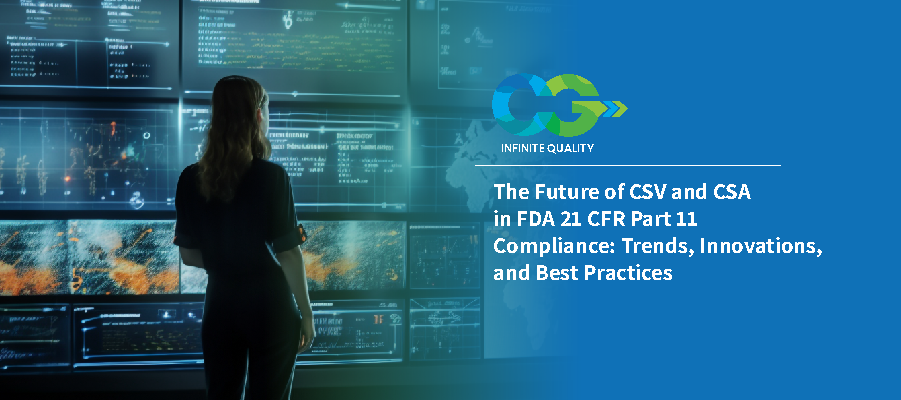The Future of CSV and CSA in FDA 21 CFR Part 11 Compliance: Trends, Innovations, and Best Practices

Article Context:
- 21 CFR Part 11 Compliance
- Computer System Validation
- Computer System Assurance
- FDA CSA 21 CFR Part 11 Compliance
- FDA CSA (vs) CSV
Title 21 CFR Part 11 is the portion of Code of Federal Regulations that provides standards determined by the Food and Drug Administration (FDA) on electronic records and electronic signatures. With electronic records widely used in the Life Sciences industry, most companies will find FDA 21 CFR Part 11 applicable.
Part 11 helps companies safely maintain data securely so that it is not lost or corrupted, ensures companies are implementing systems and software correctly, makes sure there are data-trace changes, and prevents falsified records.
New technologies, including automation and artificial intelligence (AI)/Machine Learning (ML), are entering the market as the digital world expands. These technologies are focusing on quality through unscripted, scripted, and automated testing as well as intelligent applications. This blog presents the idea of computer system assurance (CSA), explains how computer system validation (CSV) is currently carried out, and analyses how CSA regulations might refocus validation on what's crucial in the emerging world of digital technologies.
What is CSV (Computer System Validation)?
The process of establishing and upholding conformity with the pertinent GxP rules specified is known as computer system validation. By implementing ideas, techniques, and life cycle activities, one can become fit for the intended purpose. The framework for producing validation plans and reports, as well as for implementing the proper operational controls throughout the system's life cycle, is determined by the validation methodology.
What is CSA (Computer System Assurance)?
CSA, or Computer System Assurance, is a cutting-edge method of software validation that was developed under the direction of FDA regulations. The goal of this strategy is to lessen the documentation requirements of the prior Computer Systems Validation (CSV) method, without compromising the security or calibre of the final product. Pharmaceutical businesses can employ CSA regulations by using critical thinking or thorough and ongoing data examination to maintain compliance without being burdened by the excessive documentation which is formerly required by CSV regulations.
Trends of CSV and CSA in FDA 21 CFR Part 11 Compliance
Technology developments have compelled organisations to reconsider their business strategies. These organisations, which were once controlled and organised, are now more complex and chaotic, providing services to patients and clients who are more knowledgeable and have higher expectations than before. To overcome these challenges, workplace procedures and equipment must alter. To adapt to changing needs, the methodology for creating software, carrying out validation, and keeping a system in a verified state over its entire life cycle should be thoroughly thought out.
Focusing on Risk Assessment by FDA compliance requirements, Critical Thinking, and Vendor Collaboration, CSA is CSV documentation done correctly. While CSV (Computer System Validation) only assesses risk once for the entire validation process, Computer System Assurance (CSA) offers risk assessment throughout every process. A proper risk assessment must be carried out to decrease time and expense, and low, medium, and high risks should be identified. Additionally, test scripts must only be documented for high-risk components. Briefly stated CSA documentation concentrates on high-risk locations. These are the basic requirements of FDA 21 CFR part 11 compliance.
Innovations of CSV and CSA in FDA 21 CFR Part 11 Compliance
The intended usage of a system needs to be confirmed. The validation, however, needs to be line in with the degree of risk to patient safety and product quality. To ensure that testing is focused on the features or actions that pose a medium to high risk to patient safety, product quality, and/or data integrity, and less on the system's lower risk features, avoid unnecessary activities, use critical thinking, and adopt a risk-based approach as per FDA regulations and 21 CFR Part 11 compliance.
21 CFR Part 11 Compliance focuses on six critical areas:
- Impact of 21 CFR Part 11 on the client's computer systems, including Quality Management Systems
- Identification of the client's computer systems and operating environment
- Hosting and interpretation of user interviews
- Review and consideration of client procedures
- Analysis of procedural documentation, validation, and audit data
- Regulatory significance of the computer systems
Best Practices of CSV and CSA in FDA 21 CFR Part 11 Compliance
Data integrity has become more important for ensuring the compliance of systems used in regulated industries because of the FDA's recent attention to it during computer system validation inspections and audits. To support 21 CFR Part 11 compliance, data security measures like password standards should be in place to ensure the appropriate people have permissions to sensitive data. Clear audit trails should demonstrate creation, modification, or deletion to show traceability to the FDA. Implement 21 CFR part 11 guidelines on electronic signatures and ensure the FDA is aware of their use. Validate installation qualification (IQ), operational qualification (OQ), and performance qualification (PQ) to ensure software compliance. Always remember that FDA 21 CFR part 11 compliance is always the responsibility of Life Sciences companies, not the software platform.
Similarities between CSV and CSA
Similarities between CSV regulations and CSA compliance include the need for both to conduct tests and produce verifiable evidence. The main distinction between the CSV and CSA, however, is that the CSV is a fact-based, objective approach without risk assessment. As a result, the CSV best practices generate more test results. The CSV (Computer System Validation) method thus produces higher amounts of data in the form of reports. As a result, CSV documentation is a more time-consuming technique than CSA, where the number of tests required is determined by the probable consequences of the failure mode of a particular feature on the process or medical device.
Conclusion
The future of CSV/CSA in FDA 21 CFR Part 11 compliance is filled with exciting possibilities. As technology advances and regulations evolve, staying up to date with the latest trends, innovations, and best practices is crucial for maintaining compliance.
Compliance Group can give client's an unmatched, in-depth, and thorough inspection of their systems and procedures. We ensure compliance with the requirements of 21 CFR Part 11 through our years of experience and solutions that are unique to you and your company's needs.
Are you ready to embrace the future of compliance and leverage the power of AI/ML, automation, and advanced validation techniques for ensuring data integrity and streamlining your processes?
Explore our blog to gain valuable insights and take necessary steps towards optimizing your compliance strategies.
Don't miss out this opportunity to gain a competitive edge in compliance. Join us as we uncover the latest developments and equip you with the knowledge and tools to navigate the future of FDA 21 CFR Part 11 compliance with confidence.
To learn more about CG’s 21 CFR part 11/Annex 11 services, contact us today at sales@complianceg.com.
AUTHOR:
STEPHEN J COOK
VP – Validation Quality & Compliance
